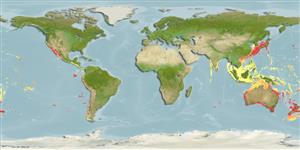>
Zeiformes (Dories) >
Zeidae (Dories)
Etymology: Zenopsis: Particle zen, derived from zao = to give life + Greek, opsis = appearance; nebulosa: nebulosus meaning dark or clouded--a dark Zeus-like fish (Ref. 4525).
More on authors: Temminck & Schlegel.
Environment: milieu / climate zone / depth range / distribution range
Ökologie
seewasser benthopelagisch; tiefenbereich 30 - 800 m (Ref. 27124), usually 50 - 600 m (Ref. 27114). Deep-water; 41°N - 54°S, 72°E - 70°W
Indo-Pacific: Japan, northwest shelf of Australia to Broken Bay in New South Wales, New Zealand (Ref. 6390), and elsewhere in the region. Eastern Pacific: off central and southern California, USA (Ref. 2850); and on the seamounts of the Nazca Ridge in the Peru area (Ref. 27131).
Length at first maturity / Size / Gewicht / Alter
Maturity: Lm 29.0, range 25 - 40 cm
Max length : 70.0 cm TL Männchen/unbestimmt; (Ref. 9563); max. veröff. Gewicht: 3.0 kg (Ref. 27124); max. veröff. Alter: 45 Jahre (Ref. 58312)
Rückenflossenstacheln (insgesamt) : 9; Rückenflossenweichstrahlen (insgesamt) : 26 - 27; Afterflossenstacheln: 3; Afterflossenweichstrahlen: 24 - 25.
Occur in deeper trawling grounds of the continental shelf and slope, close to the sea bed (Ref. 559). Caught by Japanese trawlers during winter (Ref. 559). Excellent food fish.
It is not known whether individuals undergo a single spawning or a series of spawnings over the winter months in southern Australia (Ref. 6390).
Allen, G.R. and R. Swainston, 1988. The marine fishes of north-western Australia: a field guide for anglers and divers. Western Australian Museum, Perth. 201 p. (Ref. 3132)
IUCN Rote Liste Status (Ref. 130435)
Bedrohung für Menschen
Harmless
Nutzung durch Menschen
Fischereien: kommerziell
Tools
Zusatzinformationen
Download XML
Internet Quellen
Estimates based on models
Preferred temperature (Ref.
123201): 7.1 - 23.8, mean 14.5 °C (based on 1184 cells).
Phylogenetic diversity index (Ref.
82804): PD
50 = 0.5781 [Uniqueness, from 0.5 = low to 2.0 = high].
Bayesian length-weight: a=0.01622 (0.00894 - 0.02943), b=2.93 (2.77 - 3.09), in cm total length, based on LWR estimates for this species & (Sub)family-body (Ref.
93245).
Trophic level (Ref.
69278): 4.4 ±0.72 se; based on food items.
Generation time: 16.5 ( na - na) years. Estimated as median ln(3)/K based on 2
growth studies.
Widerstandsfähigkeit (Ref.
120179): mittel, Verdopplung der Population dauert 1,4 - 4,4 Jahre. (K=0.20; tm=3; tmax=45; Fec=52,000).
Prior r = 0.49, 95% CL = 0.32 - 0.74, Based on 1 data-limited stock assessment.
Fishing Vulnerability (Ref.
59153): High to very high vulnerability (69 of 100).
Climate Vulnerability (Ref.
125649): Low vulnerability (25 of 100).
Nutrients (Ref.
124155): Calcium = 12.1 [6.5, 26.4] mg/100g; Iron = 0.32 [0.13, 0.67] mg/100g; Protein = 17.5 [14.5, 20.4] %; Omega3 = 0.349 [0.162, 0.733] g/100g; Selenium = 22 [9, 55] μg/100g; VitaminA = 16.8 [3.0, 99.8] μg/100g; Zinc = 0.281 [0.180, 0.446] mg/100g (wet weight);
